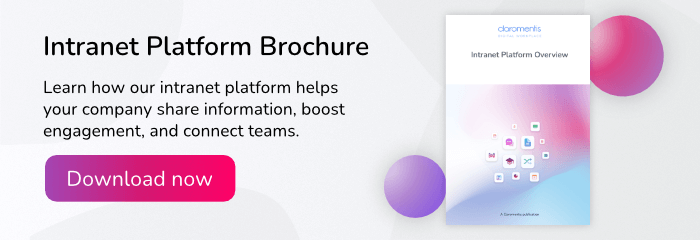There is no industry crying out for positive ‘disruption’ in the software field more than the education industry. Universities and other higher education institutions can benefit immensely from a university intranet portal that focuses on social and communication channels, yet few of them are quick to embrace this type of change.
A sense of tradition is important in education, yet it need not be applied steadfastly in the approach to IT systems and intranet platforms. In fact, establishments who stay up to date and embrace modern intranet solutions will unlock multiple benefits. We share our top 5 benefits below:
:
5 reasons why universities will benefit from intranet implementation
1. Better information sharing
Many institutions will already have a legacy university intranet portal, but outdated technology and hard-to-use interfaces can result in information becoming siloed and difficult to access.
Additionally, if departments are storing and updating intranet content inconsistently, this will result in poor usability at best or confusion at worst.
Today’s new digital workplace includes efficient document management software that makes it easy for staff to locate the information they need.
You can also create separate university intranet portals using extranet software, which provides different faculties with a secure, private network of their own to store and share files.
2. Integration with third-party apps
One of the more prominent reasons why universities are slow to improve their intranet software is that they mistakenly believe that it won’t connect with any of their third-party, specialist systems. This is not the case.
Modern university intranet portals can easily integrate with external apps via APIs, which work by connecting the systems together. That way, any data that’s held in your third-party software can automatically pull into your intranet, and vice versa.
This allows you to keep using the bespoke systems you need, whilst benefiting from using an intranet, all without overhauling your infrastructure or incurring any additional training costs.
3. Improved collaboration and communication
Intranets can – and should be – more social. Most of us use social media, yet this collaborative aspect of data sharing is often left out of university intranet portals.
Social intranet features such as internal communications tools and collaboration spaces will help improve connectivity amongst internal teams and external stakeholders. This not only speeds up collaborative communication, but can make it much faster and less cumbersome for users.
4. Increased productivity
In an institution where knowledge sharing is both frequent and voluminous, efficiency and productivity is paramount. So it’s vital that teams are working from accurate and up-to-date information. If staff aren’t sure which is the latest version of a document, then they waste time searching for an updated one or else risk using inaccurate data.
Instead, use a university intranet portal with built-in version control technology, which automatically provides users with the most up-to-date version of any document. This increases productivity, reduces human error, and saves time.
5. Enhanced staff morale
A successful intranet is one that boosts staff morale, and a modern university intranet portal is full of tools that help you achieve this.
For instance, digital rewards such as intranet badges allow both heads of departments and peers to acknowledge staff for their achievements, whilst employee recognition tools enable teams to share kudos to each other.
The above is only five examples of how a modern university intranet portal will improve the way universities manage and distribute their information. With staff having more administrative tasks to do all the time, implementing an intranet that makes it easier to share information and communicate will help support them in achieving their objectives, and in turn your institution’s long term goals.






